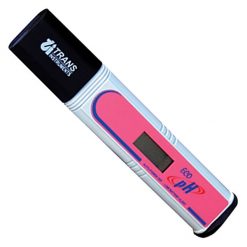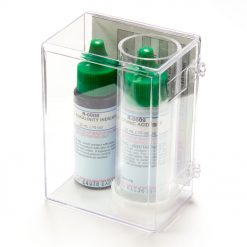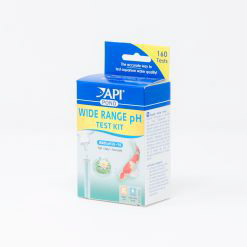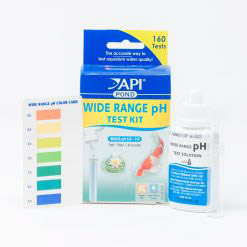pH Overview
pH is a measure of the free ions in the pond water. pH is measured on a scale from 1, which is acidic, to 14, which is alkaline, with 7 being neutral. The proper pH for different kinds of fish can vary considerably. When it comes to koi, most people agree that a pH of 7.2 to 7.4 is ideal, yet we are not sure if anyone has ever asked a koi exactly what pH he likes the best. In cases where the pH is too low (5.5), the fish can experience a condition known as Acidosis, which can kill a fish in just a few days. In cases where the pH is too high (9.5), fish can experience a condition known as Alkalosis, which can also be fatal.
Note: Koi do not like extreme pH changes. We have seen healthy koi living very happily in water with a pH as high as 9. What drives them crazy is when you keep adding acid to lower the pH to 7, and three days later, it returns to 9. If your pond’s pH was steady at 9 or below, don’t touch it. More concerning is a pH of 6.8 because you are not far away from a pH crash.
What can cause the pH to fluctuate?
A high pH is usually caused by external factors, such as lye leaching out of the cement in a pond, or rockwork touching the pond water. In some cases, the water used to fill the pond may have a high pH.
On the other hand, low pH is usually caused by organic life in the pond. The pH can drop, sometimes very quickly, due to the following reasons:
- Oxygen consumption due to the natural nitrification process of the filter. When the ammonia converts to nitrites, the process consumes oxygen and gives off carbon dioxide. The carbon dioxide then forms carbonic acid, which in turn lowers the pH.
- The fish also give off carbon dioxide, which also quickly converts to carbonic acid, thus adding to the pH lowering.
How do I control the pH?
The key to controlling the pH is to buffer the water. A buffer is anything that will bind up any free ions released into the water. Adding baking soda (sodium bicarbonate) is a quick fix to a pH crash. You could also add oyster shell, crushed coral, dolomite, or limestone, but these all react much slower and need to be placed near moving water to be effective. To check how buffered the pond is, you can test the Alkalinity.
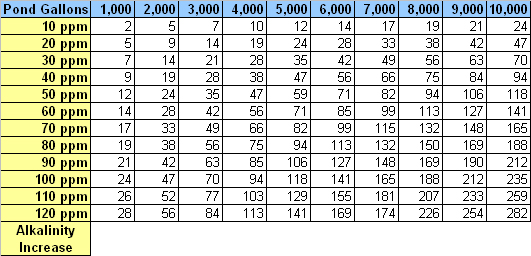
The Alkalinity or the concentration of bicarbonate in the water should measure between 90 and 120 ppm. At that level, there is little chance the pH will crash. When the Alkalinity drops down to 30 ppm, your pH can begin to swing both up and down. Adding baking soda is an easy way to increase the Alkalinity. To raise the Alkalinity with baking soda, follow the dosing chart below. The amount to be added is in ounces.

Example: If you had a 3,000-gallon pond with an alkalinity level of 30 ppm and you wanted to raise the Alkalinity to 100 ppm, you would need to increase the level by 70 ppm. Referring to the chart above, you can see that by adding 49 oz of baking soda to the pond, you would reach the desired level of 100 ppm.
Note: If the pond alkalinity is low, it can also prevent the beneficial bacteria for the biological filter from forming. When starting up a new filter, always check the Alkalinity. Additionally, no matter how much baking soda you add to the pond, the pH will not go above 8.3. At that pH, the baking soda will begin to precipitate out of solution. This is important to know because if you experience a severe pH crash and the fish are dying, you don’t need to worry about measuring out the exact amount of baking soda to adjust the pH. Just throw the whole box in the pond. We promise you, the fish will not be upset with you.
In conclusion, having a test kit for each of the basic four water parameters is invaluable to maintaining your pond. In just ten minutes, you can understand what your water quality is. As stated at the beginning, “taking the steps necessary to maintain good water quality in your pond is time well spent.”


